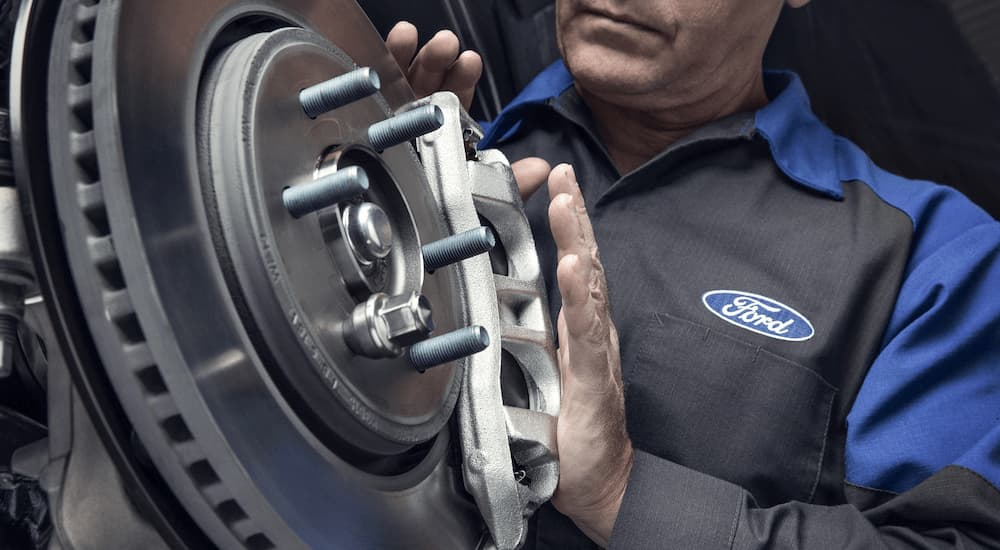Most drivers go into the vehicle-buying process having already decided that they’re in the market for either a new or used vehicle. Whether it’s a matter of budget or taste, the two categories tend to attract a specific set of drivers. Both carry their advantages and disadvantages, be it price, features, financing options, or warranty coverage, but what if there were a third option? That’s where Certified Pre-Owned vehicles come in. Not quite new, not quite used, Certified Pre-Owned (CPO) models are a great choice for any drivers seeking exceptional value. More affordable than new vehicles, CPOs also don’t come with all the potentially costly unknowns of normal used vehicles. It’s a special designation reserved for the best of the best used vehicles, but just what is the difference between used and CPO? Is the peace of mind worth the price, and how do they stack up against the brand-new competition?
What Is CPO?
CPO vehicles got their start in the 1990s when several luxury brands started to recognize the potential in re-selling vehicles that had been returned to dealerships at the end of their lease period. These vehicles were typically still in very good shape owing to their low mileage, restrictive lease conditions, and the fact that any necessary repairs had been covered under the lease’s warranty. Selling these rarefied vehicles alongside normal used vehicles seemed like a lost opportunity, and the term CPO was born. Mercedes-Benz was the first to introduce a CPO program, and the industry took notice. Now almost every auto manufacturer offers some type of CPO offering, with these vehicles representing the cream of the used car crop.
There isn’t a concrete definition of CPO, with different manufacturers using different standards to separate the wheat from the chaff. Still, there are some basic guidelines. Typically CPO vehicles are less than five or six years old, haven’t been in an accident, have fewer than 75,000 miles, and have passed some type of inspection process. These vehicles are essentially in like-new condition and, as such, typically sell for a bit more than a used version of the same model. However, that premium brings with it certain expectations about how well and how long the vehicle will continue to perform at its best.
CPO vehicles are typically offered with extended warranties, which in itself serves as an indication that a manufacturer is reasonably confident that the vehicle won’t give the driver too much trouble. A typical CPO warranty might include comprehensive coverage for the first year or 12,000 miles, with a limited powertrain warranty for seven years or 100,000 miles and a few add-ons like roadside assistance. However, as the popularity of CPO options has grown, manufacturers have started to diversify their CPO programs.
Ford was one of the first to offer two different tiers of CPO vehicles: Ford Blue Certified and Gold Certified, with Gold representing the more exhaustive certification. Both levels involve multi-point inspections, comprehensive and powertrain warranties, money-back guarantees, roadside assistance, and CARFAX vehicle history reports, providing valuable peace of mind that you won’t find with most used vehicles. However, the Gold Certified vehicles must meet higher standards, undergo more exhaustive inspections, and come with longer warranty coverage.

CPO vs Used vs New
CPO vehicles hold a number of advantages over their new counterparts. The biggest and most obvious advantage lies in the cost, with CPO vehicles typically retailing for less than a new version of the same model. But the sticker price isn’t the only cost savings associated with the CPO market. CPO vehicles are typically cheaper to insure than new models, driving down the vehicle’s overall cost of ownership. Going the CPO route also allows drivers to skip out of those first few years of a vehicle’s depreciation when it can lose as much as 20 percent of its value in just the first 12 months. By letting the previous owner take the depreciation hit, CPO drivers can make their dollar go much further; it just requires a little patience.
CPO vehicles come with extended warranties that, while not as comprehensive as the warranties offered with new vehicles, still go a long way in protecting drivers from an unexpected repair bill down the road. That’s not to say CPOs are always the best choice over new vehicles. Drivers seeking the latest amenities, specific color options, or certain features might be frustrated with the relative lack of choice within the CPO market, as few models can meet the strict certification standards. Still, when you consider the cost savings associated with opting for CPO vehicles, the choice is clear.
CPOs stack up equally well against regular used vehicles, with such programs taking much of the risk out of the buying process. Reputable dealers don’t let just any used cars on their lots and will do a cursory inspection on most of the vehicles they buy, but that’s a long way from the 172-point inspection performed by CPO programs like Ford Blue Advantage. That’s not to say regular used car shoppers are without any options. When going the used route, make sure to always ask for a vehicle history report and consider taking the vehicle to an independent third-party mechanic for a quick inspection.
Normal used vehicles may still be covered under their original factory warranty, but in reality, there’s probably a reason the previous owner decided to upgrade in the first place. As we mentioned, CPO vehicles are covered by extended warranties and generally just have a lot less wear and tear, making for a more confident buying experience. Those financing a vehicle purchase will also typically find much lower rates on new and CPO vehicles as opposed to used, as it’s more difficult to predict the future value of a used vehicle. With low mileage and a solid history of regular maintenance, CPO vehicles don’t suffer from the same uncertainty, saving drivers money and lowering the monthly cost of ownership.

Which Is Best?
Not all CPO programs are created equal. While almost all manufacturers offer some type of CPO program, they can differ greatly in terms of standards, price, and warranty coverage. Some brands treat the CPO process as just another marketing effort, slapping the CPO label on almost any vehicle that still has all the parts attached. Others hold themselves to a higher standard, with exacting metrics that ensure a vehicle still has plenty of good driving days ahead of it.
Developing a CPO program can be a tricky balancing act for brands. Set standards too low, and vehicles are bound to need repair well before the warranty is up; set them too high, and you’ll be left without much CPO inventory as most vehicles can’t make the cut. In the end, it’s up to each manufacturer to come up with its own definition of CPO, so make sure to read all the fine print when browsing such vehicles.
Luckily there are some industry experts out there who’ve made it their job to compare and rate various brands’ CPO offerings. PRIMEDIA’s IntelliChoice is the industry leader in such data, providing vehicle ratings based on consumer value, leasing cost data, and CPO program analysis since 1986. This CPO report card rates brands on nine distinct criteria: extended manufacturer warranties, title verification, certification inspection process, roadside assistance, special financing, return and exchange policies, program and dealer compliance, market penetration, and cost of ownership. This exhaustive analysis is a valuable resource for any driver diving into the CPO market, covering both the obvious (title verification, warranties, inspection) and less-obvious (roadside assistance, market penetration) aspects of various CPO programs.
Ford has always fared well in IntelliChoice’s CPO ratings, taking home the best all-around CPO Program award on more than one occasion, including in 2022. Analysts recognized Ford’s Blue Advantage CPO program as the industry’s best for non-luxury vehicles, citing the program’s special financing options as one of its major advantages. Through its Ford Credit program, Ford offers a wide array of financing options to fit the needs of almost any driver.
Ford has been offering its own in-house credit program since 1959 and has had plenty of time to perfect the process. The brand’s Standard Purchase financing option includes terms ranging from 12 to 84 months, allowing drivers to craft a payment plan that works for them. The Standard Purchase plan includes no mileage limitations, freedom to personalize your vehicle in any way you see fit, and most importantly, allows drivers to build equity with every payment. This equity can come in useful down the road, allowing drivers to earn more generous financing terms on their next Ford vehicle. CPO vehicles meeting the program’s lofty Gold Certified standard are eligible for especially favorable financing terms.
The Balance also recognized Ford’s warranty program as part of its Best CPO Warranties, with the personal finance website citing the generous 12-month/12,000-mile CPO warranty as one of the industry’s best, especially when it comes to coverage for non-standard components like navigation, audio, and other tech features. The program’s powertrain warranty is another industry-best, covering seven years/100,000 miles from the new vehicle’s purchase date and giving drivers valuable peace of mind when it comes to their engine, transmission, and other hard-to-replace components. The warranty can also be extended to subsequent owners, increasing the vehicle’s resale value and allowing you to sell with confidence, and also includes 24-hour roadside assistance, rental car allowance, and travel expense reimbursement.
Ford’s Blue Advantage CPO program has another major advantage over some of the competition. Online car shopping has come a long way from the early eBay days, but too often, it still requires curious shoppers to visit each dealer’s website individually, limiting their options to a specific geographic area. By teaming up with online vehicle marketplace leader AutoTrader, drivers can browse Ford’s CPO inventory all in one place, searching a wide selection of Ford and non-Ford vehicles. From there, customers can filter by metrics like model, trim, and features, as well as search for vehicles based on their eligibility for home delivery, at-home test drives, and video walkarounds. Bargain hunters will appreciate the site’s integrated Kelley Blue Book Price Advisor app, which rates the deal based on recent sales data, and a dealer guaranteed selling price means an end to all the games and high-pressure sales tactics of the average dealership visit.
CPO Shopping Is Better Than Ever
There are plenty of reasons to consider exploring the CPO market when it comes time to purchase your next vehicle. Not only do they represent a significant bargain in terms of purchase price, insurance rates, and financing, but they eliminate much of the risk and uncertainty from the car-buying process because they’ve received a stamp of approval from the manufacturer itself. CPO programs can differ significantly based on the manufacturer, but with a little research, it’s not difficult to find a good deal.
Ford’s CPO program is an industry standout, with generous warranty terms and a wide selection of some of the most popular vehicles on the market. That selection is now easier to browse than ever with Ford’s Blue Advantage marketplace, giving drivers across the country access to some of the best CPO vehicles around. Sure, CPO might not be for everyone, especially those who always have to have the newest, shiniest toy on the market, but for drivers with a little patience, it’s difficult to beat the value of a good CPO vehicle.



